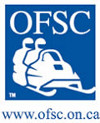OFSC Adds Public Health Unit Boundaries To Interactive Trail GuideBoundary Lines Assist Snowmobilers To Ride Locally Within Their Public Health Region(Barrie, ON: January 27, 2021) – With winter finally upon us and thousands of kilometres of trails now showing either Green or Yellow on the Interactive Trail Guide (ITG) for local riding, the Ontario Federation of Snowmobile Clubs (OFSC) has created a new tool to assist snowmobilers. As of today, we have temporarily added public health region boundaries (blue lines) to the ITG on our website, which are visible in both Trail Network and Trail Status views. They will also show on the Go Snowmobiling Ontario Apps after your next regular data update. The blue boundary lines will help you to stay within your own public health region while riding available OFSC trails and enable you to plan your local rides more easily while complying with public health measures. The OFSC reminds snowmobilers that this boundary line addition to the ITG and apps is in keeping with provincial public health measures under provisions of the Stay At Home Order that allows local exercise from your primary residence, on “outdoor recreational amenities” including snowmobile trails. For snowmobilers, this means: • No trailering at this time to destinations that are not in your public health region, especially with companions who are not members of your immediate household. Snowmobilers will note that we have not included the names of individual public health units on the ITG. The main reason is to avoid excess clutter that might make checking the ITG more difficult for its primary purpose as the sole source for snowmobile trail availability information in the province. For your information, we did explore the possibility of making the public health region boundaries and names an active new layer on the ITG that could be turned on or off at the convenience of each user. However, doing so would have involved a major backend revision requiring a temporarily, in-season shut down of the ITG while beta-testing to ensure it worked properly. Adding an untested layer was not a viable option either, because doing so could cause a major unexpected system crash that could take the ITG off-line for an indeterminant period of time when snowmobilers need it most. So instead within several days, we will be adding a separate link to a public health region map on the ITG for anyone who wants to know public health unit names. For most local riders who are familiar with their area, the new public health boundaries on the ITG should be sufficient to determine where it is, and is not, acceptable to ride close to home at this time. We understand that this announcement only benefits snowmobilers who have local trails to ride in their immediate area and region. We empathize with the frustration and disappointment of many snowmobilers who never have local trails to ride close to home. That’s why we are working diligently behind the scenes with the powers-that-be, as well as throughout our provincial trail system, to ensure that everyone will have the best possible trail riding opportunities after the Stay At Home Order is eased or lifted. Meanwhile, we can all be grateful that Old Man Winter has finally arrived and that OFSC clubs have started grooming operations so trails will be ready to ride when you are able to do so. The OFSC will continue to monitor the situation and share updates about snowmobile trails as they become available to ensure snowmobilers are informed. Please check the OFSC website, Facebook Page and the OFSC newsletter regularly for these updates. |
|
- HOME
- TRAILS & PERMITS
- CLUBSBonn TraeCalabogie & District Snowmobile ClubEganville Sno-DriftersGriffith-Matawatchan Sno-DustersHaliburton County Snowmobile AssociationKeetnaMaple Leaf Snow SkimmersMissing LinkNorth Renfrew Snowmobile AssociationOpeongo SnowbirdsPeterson PathfindersSnow Road Snowmobile ClubTimberlineWhitewater Sno-Goers
- NEWS
- EVENTS
- SAFETY
- PLANNING YOUR TRIP
- CONTACT


